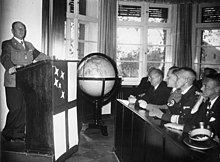Colonial Political Office of the NSDAP
The NSDAP's Colonial Political Office (KPA) was one of the main actors in German colonialism during the Nazi era . It was founded in 1934 and had the task of drawing up plans for the repossession of the former German colonies . After the office had gained in importance at the beginning of the Second World War , it was dissolved after the military change in 1943.
Beginnings
There were several predecessor organizations for colonial policy issues in the NSDAP . Most recently there was a colonial department of the party's defense policy office at the staff of the Supreme SA leadership . This went on in 1934 in the Colonial Political Office. It was initially the task of the office to issue guidelines and instructions for the party and its press for all colonial political and economic issues. In addition, the office made plans to re-take possession of the former colonies. The central task was to win supporters of colonial policy for the regime. The Reichsstatthalter in Bavaria, Franz Ritter von Epp, was appointed head of the office .
Few sources exist about the early development of the office. The headquarters were at the Reich leadership of the NSDAP in Munich . The planning department was relocated to Berlin in 1936 . The reason was the better cooperation with the colonial department in the Foreign Office . Initially, the office did not have its own budget. It was allocated its funds to a “special colonial account” by various government agencies and by the party. A significant number of the leading general speakers performed this function on a part-time basis. Only a small part were full-time employees.
expansion
The attempt by Epps to convert the office into a state colonial office by submitting a petition to Adolf Hitler in 1938 failed. However, the range of tasks has been expanded. The office was to prepare a new colonial administration, while the acquisition of the colonies should fall within the competence of the Foreign Office. In 1940, all Reich authorities were instructed to support the colonial-political office. As the office gained in importance, its financial resources also increased. In 1940, the planned expenditure was over 870,000 Reichsmarks . This meant an increase of 555%.
The internal structure also changed. The office was divided into a sub-organization for the party in Munich and a sub-organization for the state in Berlin. This colonial political office / state had four departments and around 260 employees. Of these, 36 civil servants belonged to the higher service and 44 civil servants to the upper and middle service. There were also 129 workers and employees as well as 50 part-time employees. The former envoy Rudolf Asmis was the leader .
Later there were branches in Paris and Brussels with the task of evaluating the documents of the colonial ministries there.
Structure:
Ritter von Epp
envoy Rudolf Asmis
Main Department I: Envoy Bielfeld, Foreign Office
Human Resources, Finances, Procurement, Reich Colonial Institute
Main Department II: Envoy Asmis, Foreign Office
Legal, Education, Health, Veterinary, Land Registry,
Main Department III: Bethke, Reich Ministry of Economics,
Planning, Banks, Forestry, Mining
Main department IV: Dr.-Ing. Remy, President RBD Cologne
Transport, road construction, construction industry, railway construction etc. operation, water and Port construction u. -operation, building construction, mechanical engineering
including u. a. IV F2 Helmut Schroeter
Rail Vehicles
Colonial planning
The office planned a " Central African Colonial Empire " from the Gold Coast to South West Africa and from Lake Chad to Tanganyika . In cooperation with the SS , task forces were formed to take over the colonies of the war opponents. Drafts for colonial law were drawn up and training courses were held for possible future colonial employees. The racial segregation was prepared particularly comprehensively by a "Colonial Blood Protection Act."
The End
With the change in World War II in favor of the Allies, the office quickly lost its importance. At the beginning of 1943, by order of Hitler, party offices that were not important to the war effort, including the Colonial Political Office, were closed. The Reichskolonialamt and the Reichskolonialbund were finally dissolved on February 17, 1943. With the Control Council Act No. 2 of October 10, 1945, the Colonial Political Office was additionally banned by the Allied Control Council and its re-establishment was prohibited.
See also
literature
- Alexandre Kum'a N'Dumbe: What did Hitler want in Africa? National Socialist plans for a fascist reorganization of Africa (= critical and self-critical research reports on the Third World. Vol. 7). Editor of the German manuscript: Richard Lakowsky. Verlag für interkulturelle Kommunikation IKO, Frankfurt am Main 1993, ISBN 3-88939-104-4 (first in French: Hitler voulait l'Afrique. Le projet du 3ème Reich sur le continent africain. Éditions l'Harmattan, Paris 1980, ISBN 2-85802-140-6 (At the same time: Lyon, University, PhD dissertation, 1975: La Politique africaine de l'Allemagne hitlérienne, 1933–1943, Afrique du Nord, Afrique centrale, Afrique du Sud. )).
- Marc Grohmann: Exotic Constitution. The competences of the Reichstag for the German colonies in legislation and constitutional science of the German Empire (1884–1914) (= contributions to the legal history of the 20th century. Vol. 30). Mohr Siebeck, Tübingen 2001, ISBN 3-16-147532-1 (also: Berlin, Humboldt University, dissertation, 2000).
Web links
notes
- ↑ in French as a document in Kum'a N'Dumbe, see Ref., Pp. 365–367; trans. from the Federal Archives, Koblenz 22/2365
- ↑ different subtitle on the cover: ... Les plans secrets pour une Afrique fasciste 1933–1945.
- ↑ Despite the different title, he takes over from Kum'a N'Dumbe the 9th draft for a "colonial constitution" of July 10, 1940 from the Federal Archives (Germany) #R 22/2365, p. 288f.
